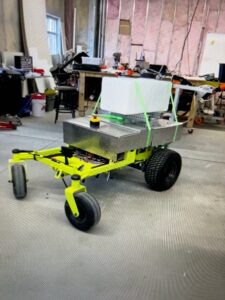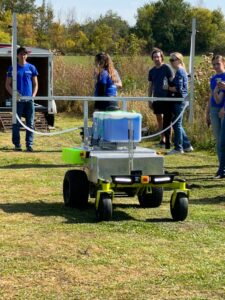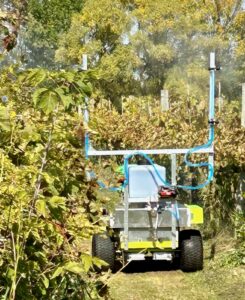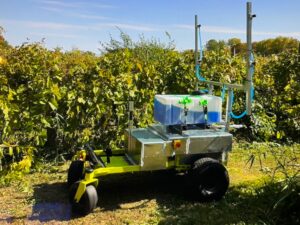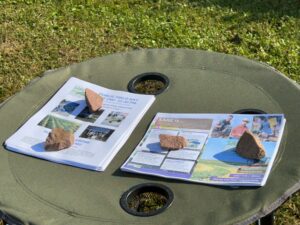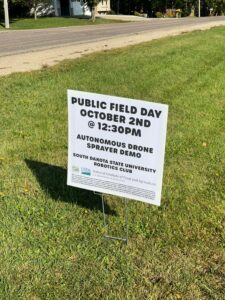Final report for FNC20-1240
Project Information
My family farm is 42 acres with 36 tillable acres and is a “rural farm in an urban setting” on the eastern border of Owatonna, Minnesota. The farm has been in the family since 1947.
At present, the specialty crop farm has 24 acres of managed haylage which is marketed to the horse industry as high quality horse hay.
The remaining 12 acres of tillable land has been planted into vineyard over the last nine growing seasons. We are planning to continue expansion of the vineyard every year until we reach 22 acres of wine grape production. The vineyard has a drip irrigation system installed for both targeted fertilization and “climate change” drought defense.
I am a professional licensed mechanical engineer and have been involved with the family farm for over 40 years. My engineering firm has been involved in designing Buffalo Lake Ethanol Plant in Fairmont, Minnesota along with numerous microbreweries, wineries, and a distillery. I worked with Bushel Boy Farms and its hydroponics environmental systems and tomato processing.
In 2019 I designed a food processing pilot facility for LZL Engineering, which specializes in food additive processing.
In the 1970’s during my college years at South Dakota State University (Brookings, South Dakota), I worked on a research project gathering data on farmland water runoff and water temperature of lakes and ponds in eastern South Dakota along the border of Minnesota. The project was funded by a GE Climate Change grant to two SDSU professionals with degrees in thermal and fluid dynamics and who had worked on the moonshot with NASA in the 1960’s.
The drone sprayer will contribute 1.1 tons of CO2 to the atmosphere compared to 11.1 tons of CO2 for a 55 Hp tractor sprayer, which is 90% less CO2/year using the drone.
My next generation specialty farm is being designed and built as a high value added farm vs. a general commodity crop farm (corn, soybean, wheat, etc.). A farm winery/distillery is the next step and is being designed with “climate change” and low environmental impact in mind using solar energy with battery storage and artificial intelligence and the drone sprayer is part of the overall farming plan.
The vineyard canopy has been under attack by the invasive species, the Japanese beetle, for the last six seasons. The beetles attack the upper canopy starting from late June through early September. The canopy damage lowers grape quality, harvest yield, and causes uneven ripening of grape bunches.
We have experimented with milky spore along with grass and weed herbicide control to eliminate the vegetation between rows and under vines. Together they have lowered the number of beetles but not enough to improve overall production of grape quality and yield. We still have 20-30% canopy loss plus the canopy regrows first taking nutrition from the grapes.
A traditional tractor uses 25 gallons/acre vs. 2.5 gallons/acre using a drone, which in turn cuts down on environmental damage. Also heavy rains have not allowed a tractor sprayer to be run in the field. Drone spraying is not affected by rain.
I am proposing precision agriculture by using a drone sprayer system to control the beetle from overhead using 70% less pesticides, decreasing chemical drift and evaporation with greater adherence of chemicals to leaves and beetles on vines. I believe production can be increased by 150-200% through better control of the beetle using aerial spraying.
Update: 2/8/2021
Due to the COVID-19 Pandemic, supplies from China have been severely interrupted. The Joyance 10L Electrostatic Centrifugal Drone Sprayer and similar drones, for example, were unavailable in the United States during 2020. FAA rules and regulations are continuing to evolve regarding sprayer drones. Because I was unable to begin actual field trials no money from the grant has been spent. A website: vineyard.icecycle.com was created and continues to be updated.
In order to have an accurate baseline for the upcoming growing season and trials, I recorded chemical application (dates and field areas) as shown on the attached Japanese Beetle Control (Conventional Spraying) -2020 spreadsheet. Production in pounds for the ten rows of vines in full production is identified in the attached spreadsheet: Production 2020.
Objectives remain the same. In order to have two full growing seasons for research/trials an extension request will be forthcoming along with some budget adjustments.
Japanese Beetle Control (Conventional Spraying)--2020 - Sheet1
Production September 2020 - Sheet1
Update 1/1/2022
Due to pandemic shortages and ever changing government regulations it will take two to three years to receive certification from the FAA to use an aerial drone sprayer. I plan to change to a ground based robotic drone sprayer. Aerial sprayers can reduce the use of chemicals by 70% over conventional broadcast spraying. According to Precision Agriculture Technology for Crop Farming (Washington State University), a ground based robotic drone can use 90% less pesticides to achieve similar efficiency to conventional broadcast applications. A ground based robotic sprayer will offer safety for the operator as well as the environment as in my original proposal.
On July 7, 2021, I received approval for an eleven month extension of the grant and a change to a ground based drone. The Ryobi platform was purchased in July 2021.
Purchased the electrostatic ULV Fogger sprayers in June and late August (second fogger was out of stock until August 22, 2021).
Japanese Beetles arrived unseasonably early in 2021 (June 24th) and died out early by August 11th, so I was unable to begin testing the ground based sprayer. I am able to design the mechanical and pumping systems.
The sprayer must be able to navigate a 500 foot plus vineyard row, which is nine feet on center with a eight foot wide lane down the center of the row, with end rows 25 feet wide. One acre of vineyard is roughly ten rows wide. The vehicle will need a RC and “Follow Me” Bluetooth or WiFi IPhone mode of control, along with the autonomous mode, after being unloaded in vineyard. The goal is to spray at least three acres per battery charge. SAFETY SHUTDOWN SYSTEM IS REQUIRED.
I will be providing the 48 volt, 100 amp, main battery power vehicle framework with a 42 inch mower deck (Ryobi ZTR Mower). This platform can be modified to become an autonomous sprayer. Also, included are two electrostatic sprayer units which operate on 48 volt battery packs. These units can be modified and integrated into the robotic vehicle systems with end row shutdown during turns. A sprayer reservoir tank may be needed to meet spraying requirements. It is up to the design team to decide.
Japanese Beetle Control (Conventional Spraying) 2021 - Sheet1.pdf
Update: 3/1-12/31/2022
Plans fell through for the autonomous drone sprayer to be part of senior engineering projects at South Dakota State University (SDSU) in January 2022. Instead the Robotics Team at SDSU took over the project in March 2022 when the base platform was shipped to SDSU. I’ve included my original design/concept of the sprayer which was shared with the club.
Twenty-three students have been working approximately five-six hours each per week with a break over summer. Progress on the autonomous sprayer includes a cover to waterproof the electronics and connect to the batteries. Sprayer arms were made and attached onto the platform. CPU board was added to the sprayers to be controlled by remote control. Emergency stops and obstacle detection sensors were added.
On Oct. 2, 2022 a Field Day was held to demonstrate and test the remote control autonomous drone sprayer. Included are images from the Field Day. Also see the grant website for additional images and videos of the sprayer in action.
Ideally the autonomous sprayer would have been ready earlier in the season for testing against the Japanese Beetle but 2022 was an unusual year for the Japanese Beetle. Because of the drought the beetle only appeared for approximately three weeks with very little damage to the vine leaves. The damage was limited to the first few rows to the east and west ends of the fields and along the north/south edges of the fields (in about six plants). See the vineyard, production, and spraying attachments for 2022. This information shows the limited appearance of the beetle and limited need for spraying. The vineyard map shows the location of the vineyard rows within the entire Natzel farm and the specific location of the rows in the grant.
Note that because of the drought and high temperatures Frontenac Gries production was lower compared to prior harvests. Marquette production on the other hand was considerably higher due to the summer temperatures and lack of water and limited beetle damage. Other Minnesota vineyards experience the same results–especially the bumper Marquette crop.
Enhancements to the autonomous drone sprayer will continue. Two cameras, a lidar sensor for obstacle detection, and GPS software so the sprayer will drive by itself will be added in 2023. The vineyard.icecycle.com website will provide updates as the project progresses.
Production 2020, 2021, 2022. Sheet 1
Japanese Beetle Control (Conventional Spraying) 2022
The objective is to lessen pesticide usage to control the Japanese beetle which in turn will do less environmental damage to soil, water, animal and human life.
The speed of the drone, the spray amount, the drone altitude and the ratio of pesticide to water mixture will be controlled. Drone use will speed up spraying the 12 acres, which will lessen the health risk from chemicals on the sprayer operator along with less pesticide drift by using 90% less liquid.
Another objective is to reduce the vine canopy beetle damage caused by the Japanese beetle in order to increase production.
Research
The test site for the research will take place on four acres of the existing vineyard, which I own.
Each acre plot will have different parameters set for the ground based drone spraying research as follows:
- Speed of ground based drone between rows of vines.
- Pesticide dispensing rate per acre.
- Pesticide to water mixture ratio will follow manufacturer's guidelines.
- Different height and angle settings of electrostatic sprayer nozzles will be varied for this test.
- Ground drone will be controlled by system modules (Sonar, Radar, Vision and RTK GNSS).
- Preprogrammed path will be followed by sprayer in vineyard rows.
- Ground Speed was lowered from 6 mph to 3 mph based on testing (Oct. 2, 2022) using the misting sprayers.
- Pesticide dispensed per acre went from 90% less to approximately 80% less than conventional spraying because of the misting sprayer nozzles which were used instead of the electrostatic spraying system. The electrostatic spraying system had durability problems which have not been solved at this time
- Pesticide to water mixture is 32 oz pesticide/25 gallons of water. This is based on pesticide suppliers.
- The best setting based on field trials for the misting sprayer nozzles is at 6’ and 4’ height above the ground. Best angle setting for both nozzles is perpendicular to the vineyard rows.
- Because of supply chain problems the autonomous drone sprayer was RC controlled during field tests. Radar, vision system and GPS modules are ordered. The modules will be incorporated into the autonomous sprayer beginning in January 2023 by the Robotics Club.
- The Software Team which is part of the Robotics Club is in the process of writing the program using the new GPS system modules
- Misting arms were moved from a width of seven feet to four feet to move down the eight foot vineyard rows. This was needed for the sprayer to fit down the row and provide good spray coverage on the leaves. Robotic team members remarked that they were glad they had made the arms adjustable!
- Heat dissipation of the motors/battery was a concern. We tried leaving the bottom of the waterproofed motor/battery box open to dissipate the heat but found that the box needed to be fully enclosed due to the chemicals. A better solution is to add a cooling fan to the box.
- Also the green control box which contains on/off switches and breakers needed improved waterproofing and possibly replacement with waterproof switches and breakers.
Despite not being able to actively use the autonomous drone sprayer during the growing season due to the pandemic and supply chain problems we were still able to build a working drone sprayer.
The ultimate objective with the sprayer is to reduce chemical use and increase safety for vineyard workers and increase production while limiting Japanese Beetle damage. With testing we found that the sprayer will reduce chemical use by 80% and once the GPS module system is installed reduce human contact with chemicals thus increasing safety.
The 2022 season foreshadows what can happen when Japanese Beetle damage is limited. The Marquette field had very little leaf damage along with below average rainfall. The vines flourished. The precipitation for the months of May-Sept. was 14.74”. Historically, the precipitation is 21.67”. The rain amount was measured in a rain gauge placed on a post in the north field. In previous years the leaves of the Marquette vines in the first six-eight rows (west end) were heavily damaged by the beetle. With less damage (and lower rain amounts) the Marquette harvest skyrocketed as shown on the Production chart under the Summary Section of this report. Climate change definitely will affect production going forward.
The first two rows (west end of field) of the Frontenac Gris field which normally would experience heavy beetle damage also flourished but to a lesser extent. I think the other rows were affected by the reduction in precipitation.
Data Collection (shown in the Summary Section of this report) over the past three years of the grant will also be helpful in understanding climate and production trends and the effect the sprayer will have on future production.
With my design and guidance and the talents of the students at SDSU I have a working drone sprayer. It will lessen pesticide usage which will do less environmental damage to soil, water, animal and human life. In 2023 enhancements made to the sprayer will further this objective. Updates to progress will continue through my SARE Grant website and through presentations/Field Days.
Educational & Outreach Activities
Participation Summary:
Outreach
South Dakota Robotics Club (SDSU)
Members working on autonomous drone sprayer
Robotics Club Website
Includes information on autonomous drone sprayer
Impulse Magazine –Spring 2022
Article about autonomous drone sprayer
Field Day Demo/Testing
Oct. 2, 2022 Owatonna, Minnesota
SARE Grant Website (IFM Brands)
Created by and updated by William and Jaclyn Natze
Details:
South Dakota Robotics Club
Twenty-three students are actively working on the sprayer. Specialized teams working on the sprayer include: the mechanical design and fabrication team, electrical design team, software team, sprayer system design team, and field test team.
The autonomous drone sprayer project was used as a successful recruiting tool. Forty-eight new members joined in Oct. 2022. Some will be working on the sprayer. Additional software team members will be added.
Robotics Club Website:
The Robotics Club includes information about the sprayer on its SDSU website:
https://www.sdstate.edu/electrical-engineering-and-computer-science/robotics-club
Impulse Magazine- Spring 2022
Impulse Magazine which is a twice annually published magazine by University Marketing and Communication and the Jerome J. Lohr College of Engineering at SDSU included an article about the start of the autonomous drone sprayer project in its Spring 2022 issue. There will be a follow-up article in the magazine in 2023.
Field Day Demo/Testing
The autonomous drone sprayer demonstration and testing was held in the south field of the Natzel farm on Oct. 2, 2022.
One neighbor after learning about the sprayer has offered the Owatonna Foundation to pay for the FFA students at the Owatonna High School to be bused to the Natzel farm for a future demonstration event. Approximately 25 attended. Fliers and field-side sign were created. Also included was the brochure describing SARE. Those interested in the vineyard were emailed about the field day.
SARE Grant Website (IFM Brands)
The website includes information about the SARE Grant and the autonomous drone sprayer project. Videos and images of the sprayer are included. The website will continue to be updated as the project progresses in 2023.
Learning Outcomes
I would recommend encouraging other groups or organizations to be involved early to help promote your project. For example, in my case I would seek involvement with the Owatonna Foundation and the Owatonna High School Newspaper (the Magnet). I would also recommend contacting magazines/websites about your project to further publicity. Also be sure to create your own SARE Grant website and keep it up-to-date.
I overcame the barrier of not being able to build an aerial drone sprayer due to FAA regulations and the pandemic by switching to a ground drone sprayer. I would tell other farmers or ranchers that autonomous equipment in agriculture is just starting and to get ready for robotic farming in the near future. I’d recommend they read up on the topic and go to demonstrations where possible.
Project Outcomes
Information Products
- Custom Vineyard Robot (Article/Newsletter/Blog)
